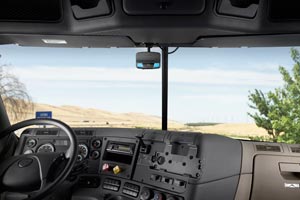Managing Editor, Features and Multimedia
Lytx Expands Video-Based Safety Technology to More Closely Track Driver Fatigue, Distraction

The company’s new ActiveVision service, set for industrywide release in January, uses onboard sensors and analytics to identify signs that the driver is drowsy or distracted, such as lane departures and following too closely.
Based on that information, the system issues audible alerts to the driver in real time and provides feedback for driver coaching after the fact, according to the San Diego-based technology supplier.
ActiveVision uses new hardware equipped with “machine-vision” technology that tracks road markings and the environment in front of the truck, including other vehicles.
During an Oct. 18 demonstration of the technology here at American Trucking Associations’ Management Conference & Exhibition, CEO Brandon Nixon said the company’s algorithms can detect even subtle changes in driving patterns, including swerving back and forth within a lane and slowing down relative to the surrounding traffic.
.@lytx CEO Brandon Nixon discusses the company's new ActiveVision technology at #MCE2015 pic.twitter.com/c07oZBHJGt
— Seth Clevenger (@SethClevenger) October 18, 2015
“We view distracted and drowsy driving as an enemy to all of us,” Nixon said, adding that the new service has been in development for about four years. ActiveVision works in conjunction with the video feeds and accelerometer data that Lytx already captures with its DC Enterprise and DC Protect programs.
“The most sophisticated technology in the cab will always be the human operator,” Nixon said. “We created a system to augment the natural strengths of the human driver that leverages vast amounts of data, understands what that data means and what’s important, and how that data can be used to make the roads safer for everyone.”
ActiveVision is designed to reveal patterns in driver behavior to support fleets’ efforts to improve safety, said Liz Eller, senior manager of product marketing.
“The technology shows us not only the individual lane departures and points of following, but also the trend happening over time,” she said. “Did it happen just once, or did [the driver] continue to swerve on the highway or follow too close to the vehicle ahead? There’s a big difference between a one-time event and an ongoing pattern of behavior.”
ActiveVision will utilize Lytx’s new ER-SV2 event recorder, the company’s fifth-generation device, which includes the new road-marking and vehicle-monitoring capabilities. Like the company’s previous hardware, the new device records video both outside and inside the cab with forward- and driver-facing cameras and includes accelerometer and gyro sensors to capture additional driver-performance information. The ER-SV2 can collect data from the truck’s engine-control module and third-party onboard technologies and offers Bluetooth and Ethernet connectivity.
ActiveVision also incorporates a feature that Lytx calls AutoTune, which is designed to reduce the likelihood of false alerts by continuously fine-tuning its pattern-recognition algorithms based on reviews of captured events.
To implement the ActiveVision service, current DriveCam users will need to upgrade to the new hardware, Eller said. However, Lytx will continue to offer its DC Enterprise and DC Protect programs using the current event recorder, she added.
Lytx also will continue to offer integrations with third-party suppliers of active safety systems, Eller said.
ActiveVision is available now for select DriveCam users, with the industrywide rollout to follow in January, Lytx said.
Nixon said Lytx has 250,000 onboard video recorders in service worldwide, with about 80% of that total in North America.
Frost & Sullivan said in a June report that Lytx holds about 70% of the global video-safety market for trucks, which the research firm expects to quadruple from about 310,000 units in service in 2014 to about 1.25 million in 2021.

